Intel challenged IBM and Google with supercomputers with 250 times cooler temperatures than the universe
On Tuesday, Intel introduced a 17-bit superconducting chip, similar to the largest quantum computer chip ever produced by IBM.
So far, quantum computing has become a race between IBM and Google. In April, Google introduced a 9qubit chip study and another study could break the record of quantum computing by the end of the year. In May, IBM introduced the first 17qubit chip.
IBM products are based on research conducted by Professor Robert Schoelkopf at Yale University (IBM group consists of PhD PhDs, students studying PhDs). Google products are based on research by California University Professor John Martinis, supported by Google in 2014.
All researchers from IBM, Intel, Google or anywhere else, such as Microsoft, are in the race for a 50qubit chip. That's the level of need to create a supercomputer stronger than any supercomputer. No one knows what fast and smart computers can solve these problems.
Quantum entanglement
Quantum computers are different from digital computers today. Digital computers think in two states: 1 and 0 (turn on and off), but quantum computers use combinations 1 and 0 to create more complex states, which can be 1, 0, both 2 at the same time or (strangely) some in the middle, a mysteriously difficult state to describe.
This confusing state is called 'quantum entanglement', and there are also some mathematical formulas (or algorithms) that use this state to calculate things that traditional computers aren't powerful enough to calculate. For example, quantum computers can work with billions of variables at the same time.
They are also used for machine learning. These computers are expected to find new remedies, how to secure new computers. This form of calculation is also expected to create a computer that can be thought of to create a human-like robot or a personalized medicine for each person.

Intel's Quantum Hardware Manager, Jim Clarke with 17-bit superconducting test chip in hand
This may sound difficult but the journey is not alone. Microsoft also bet on quantum computation even though Bill Gates himself admitted that he did not really understand how it worked.
Temperatures are colder than the universe
Until now, the challenge was simply to create a larger quantum computer. As Intel explains, qubits are very fragile. Any small sound or dispersion can cause data loss. They depend and superconducting metals need to be kept at a very cold temperature of 20 milligrams - or 250 times cooler than outer space. This condition is difficult to create and maintain.
Temperature is not the only problem. Quantum computers are larger in size when adding multiple qubits and can also cause many errors.
But the speed of development is still very fast. In May 2016, IBM introduced the world's first 5qubit machine and cloud service. After only one year, these chips were three times larger.
Google expects to create a large and powerful test computer by the end of the year, which can perform calculations that traditional supercomputers can't do, called the supreme quantum world or the quantum throne.
At the same time, Intel also threw himself into the game. Below is more detailed information about Intel's chip.
The 17qubit chip has a square with connect gold that allows the chip to connect to the world outside the quantum computer.
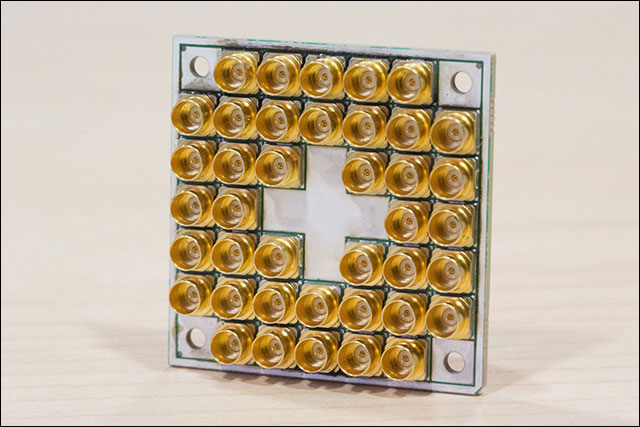
Intel's 17qubit square chip
This is a picture of the other side of the chip when packaged in a box. One of the things Intel is aiming for is mass production of this chip. That would be much more difficult to create a test chip.
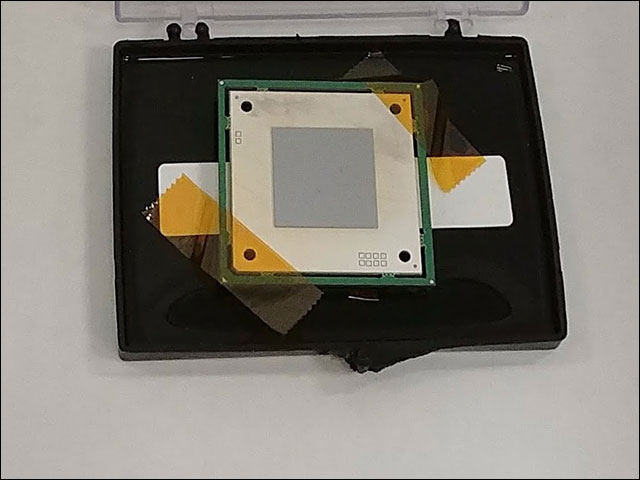
Quantum chip testing package in box
There is much to be done before this technology is ready for production. Researchers at QuTech's quantum computing lab are focusing on that.
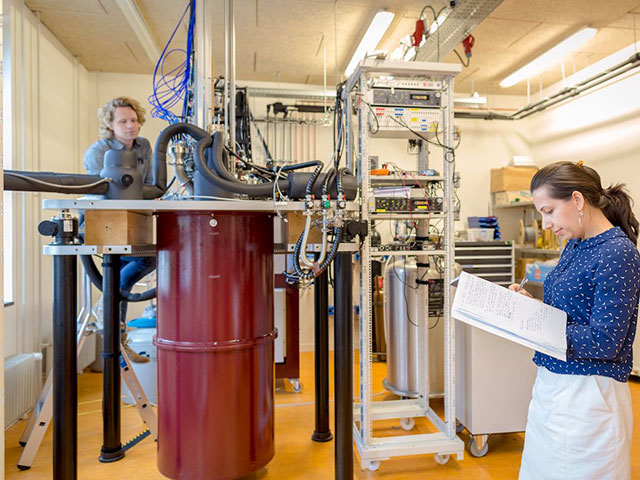
There are many things to improve before producing large quantities of quantum chips
IBM's quantum computer lives in this white tube. It is a special refrigerator to keep temperature 0 completely.
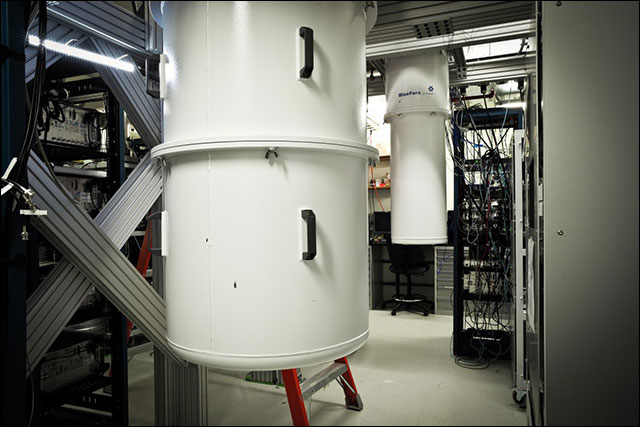
Need to keep the temperature very low for quantum computers
QuTech Leo DiCarlo and Intel scientist Dave Michalak are very interested in the new chip, have made this video, in which they explain in more detail how the chip was created.
You should read it
- For the first time scientists photographed the phenomenon of quantum entanglement, which Einstein once called 'spooky impact'.
- For the first time, scientists have successfully implemented quantum shifts between two chips
- New chip technology can enhance quantum computing
- Insert the photon into the empty space inside the diamond
- Google achieves new achievements in quantum computing with the 53-qubit Sycamore chip
- Google's quantum supercomputer can solve the 'impossible' calculation in just 200 seconds
- What is quantum computing and how did people develop this technology?
- Quantum computing - a marathon, not a sprint contest!
May be interested
- How will the universe end?
 will the universe end in a big freeze, a big rip – or something even stranger? take a look into the distant future with astronomers from the royal observatory greenwich.
will the universe end in a big freeze, a big rip – or something even stranger? take a look into the distant future with astronomers from the royal observatory greenwich. - 9 reasons you should choose a cooler instead of air conditioner
 coolers can be used in open spaces, high mobility, not drying skin, saving electricity so many people believe more than air conditioning.
coolers can be used in open spaces, high mobility, not drying skin, saving electricity so many people believe more than air conditioning. - The 7 most powerful supercomputers today
 supercomputers play an important role in scientific discoveries, from predicting climate change to discovering new drugs.
supercomputers play an important role in scientific discoveries, from predicting climate change to discovering new drugs. - Detects the hottest outer planet in the universe, with temperatures up to 4,327 ° C
 a new, hottest gas outlier has been discovered by american scientists around a mother star with twice the sun's temperature.
a new, hottest gas outlier has been discovered by american scientists around a mother star with twice the sun's temperature. - 9 amazing facts about the universe amaze you
 the vast universe contains countless mysteries waiting for people to discover. how many stars in the universe, how the earth is shaped ... are the mysteries of the universe that have a strong attraction to all those who love to explore the universe.
the vast universe contains countless mysteries waiting for people to discover. how many stars in the universe, how the earth is shaped ... are the mysteries of the universe that have a strong attraction to all those who love to explore the universe. - Top 5 best Intel CPUs 2022
 intel has always been at the forefront of gaming and productivity, with a series of new chips that vastly improve on the previous generation while also outperforming rival amd.
intel has always been at the forefront of gaming and productivity, with a series of new chips that vastly improve on the previous generation while also outperforming rival amd. - Thanks to light, we know the history of the universe and the composition of distant celestial bodies
 how do scientists study the universe when they don't set foot on it?
how do scientists study the universe when they don't set foot on it? - Google cherishes the launch of a new messaging app
 according to the economic times economic times, according to some reliable sources, it seems that software giant google is planning to launch a new messaging application for mobile, independent of talent. google account, and may be tested in india and other emerging markets.
according to the economic times economic times, according to some reliable sources, it seems that software giant google is planning to launch a new messaging application for mobile, independent of talent. google account, and may be tested in india and other emerging markets. - Can Intel reduce product prices before AMD Ryzen 3000 officially launches?
 going through a few large technology forums in recent times, there are a lot of rumors surrounding intel being able to prepare a significant discount of some of its high-end cpu models before the ryzen product launch event. amd's 3000 officially took place.
going through a few large technology forums in recent times, there are a lot of rumors surrounding intel being able to prepare a significant discount of some of its high-end cpu models before the ryzen product launch event. amd's 3000 officially took place. - TOP 10 supercomputers with fastest processing speed in the world
 help you better understand supercomputers, introduce top 10 fastest supercomputers in the world with information about the country of ownership, processing speed and top performance.
help you better understand supercomputers, introduce top 10 fastest supercomputers in the world with information about the country of ownership, processing speed and top performance.


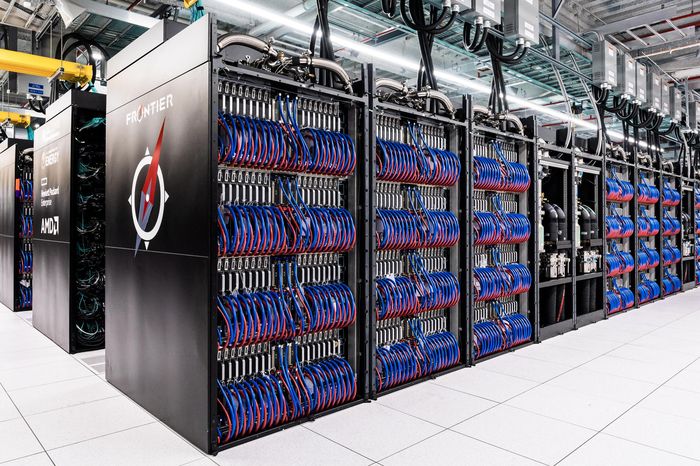







 New Google security features protect users from unverified applications
New Google security features protect users from unverified applications Mozilla launched the first open source voice recognition engine
Mozilla launched the first open source voice recognition engine Download application to make super smooth GIF image of Motion Stills of Google just arrived at Android
Download application to make super smooth GIF image of Motion Stills of Google just arrived at Android You may soon be using Microsoft's Cortana to control the temperature
You may soon be using Microsoft's Cortana to control the temperature Google Street View now brings the universe out of space
Google Street View now brings the universe out of space Things to know about thumbnails with YouTube GIFs
Things to know about thumbnails with YouTube GIFs